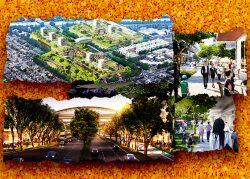Sand Hill Property has scaled back plans for a 7 million-square-foot redevelopment of a former mall in Cupertino, ditching its apartment towers and the world’s largest “green roof.”
The Palo Alto-based developer has responded to economic conditions by shaving 1 million square feet from its proposed retail village at 10123 North Wolfe Road, the Silicon Valley Business Journal reported, citing interviews with Sand Hill executives.
Sand Hill, in a nearly decade-long battle with the City of Cupertino and local residents over what to do with its Vallco Shopping Center, pitched a plan last year to redevelop the now 51-acre lot into a city-within-a-city.
The $4 billion project, known as The Rise, was to include 2,402 homes, half of them affordable, and more than 2.3 million square feet of offices, labs, shops and restaurants.
Designed by Rafael Viñoly Architects, the plan included what would have been the city’s tallest residential towers and a 29-acre green roof, touted as the world’s largest. The project was supposed to break ground this year.
Kohn Pedersen Fox Associates will take over architectural design from Rafael Viñoly, whose founder passed away last year. A new rendering shows a russet seven-story apartment building, fronted by wings of bustling shops.
Plans now call for eliminating the green roof and the project’s 240-foot residential towers in favor of 7 acres of ground-level parks and more housing in buildings no taller than 85 feet, Reed Moulds, managing director at Sand Hill, told the Business Times.
The Rise would add 269 more units, 11 percent more than previously planned, for a total 2,671 homes. It would also cut the affordable segment to 890 homes for low-income households, from 1,201 affordable units.
Sand Hill Property secured full financing for the project from the Abu Dhabi Investment Authority, a boon since few companies tend to build affordable housing without public funds.
The project’s 1.9 million square feet of offices would be cut by 30,000 square feet. And while its proposed 429,000 square feet of shops and restaurants would remain unchanged, they would feature fewer “big box” stores and more “experiences,” Moulds said.
Moulds said the revisions are necessary to make The Rise economically feasible, and to finance the project in the current economy. The developer also decided to heed changes requested by the community, including scrapping the 240-foot towers.
The new proposal also remains compliant with Senate Bill 35, a state law the developer invoked to override local opposition to the project. Passed in 2017, the measure requires a percentage of homes be set aside for households making below 80 percent of the area median income.
— Dana Bartholomew
Read more



